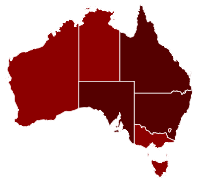2009 flu pandemic in Australia

Deaths
Confirmed cases
|
|

5000+ confirmed cases
500+ Confirmed cases
50+ Confirmed cases
5+ Confirmed cases
1+ Confirmed cases
|
|

1+ deaths
5+ deaths
20+ deaths
Influenza A H1N1 2009 swine flu outbreak evolution in Australia
|
|
| Disease | H1N1 Influenza (Human Swine Influenza) |
|---|---|
| Virus strain | H1N1 |
| Deaths | 191 |
| Confirmed cases | 37,537 |
| Suspected cases‡ | n/a |
| ‡Suspected cases have not been confirmed as being due to this strain of influenza by laboratory tests, although some other strains may have been ruled out. | |
As at 18 December 2009, Australia had 37,537 confirmed cases of H1N1 Influenza 2009 (Human Swine Influenza) and 191 deaths reported by Department of Health but only 77 deaths reported by the Australian Bureau of Statistics. The actual numbers are much larger, as only serious cases are being tested and treated. Suspected cases have not been reported by the Department of Health and Ageing since 18 May 2009 because they are changing too quickly to report. As many as 1600 Australians may have died as a result of this virus. On 23 May The federal government classified the outbreak as CONTAIN phase except in Victoria where it was escalated to the SUSTAIN phase on 3 June. This gives government authorities permission to close schools to slow the spread of the disease. On 17 June 2009 the Department of Health and Ageing introduced a new phase called PROTECT. This modified the response to focus on people with high risk of complications from the disease. Testing at airports is to be discontinued. The national stockpile of antiviral drugs will no longer be made available to people with the flu unless there are more than mild symptoms or a high risk of dying.
Australia has a stockpile of 8.7 million doses of Tamiflu and Relenza. Under the earlier DELAY and CONTAIN phases Airlines were required to report passengers with influenza symptoms, and thermal imaging and nurses were deployed at international airports. Passengers arriving were required to fill in a health declaration card.
A large scale immunization effort against swine flu started on Monday 28 September 2009.
There are on average 2,500-3,000 deaths every year as a result of seasonal influenza in Australia. An estimated 1 billion are infected seasonally, throughout the world. In Australia, 37,537 swine flu tests have given positive results and there have been 191 confirmed deaths of people infected with swine flu as of 18 December 2009.
On 9 May 2009, Australia confirmed its first case of swine flu in a 33-year-old woman, when she touched down from a flight from Los Angeles to Brisbane. Although it was confirmed to be not infectious (coming out as a "weak but positive result"), family members and people who were sitting close to her during the flight have been contacted and urged to seek immediate medical attention if they began to show flu-like symptoms. On 24 May Queensland confirmed its second case. 41 deaths have been recorded in Queensland. The first person to die in Queensland was a 38-year-old woman who died on 15 July at the Mater Hospital Pimlico.
...
Wikipedia
